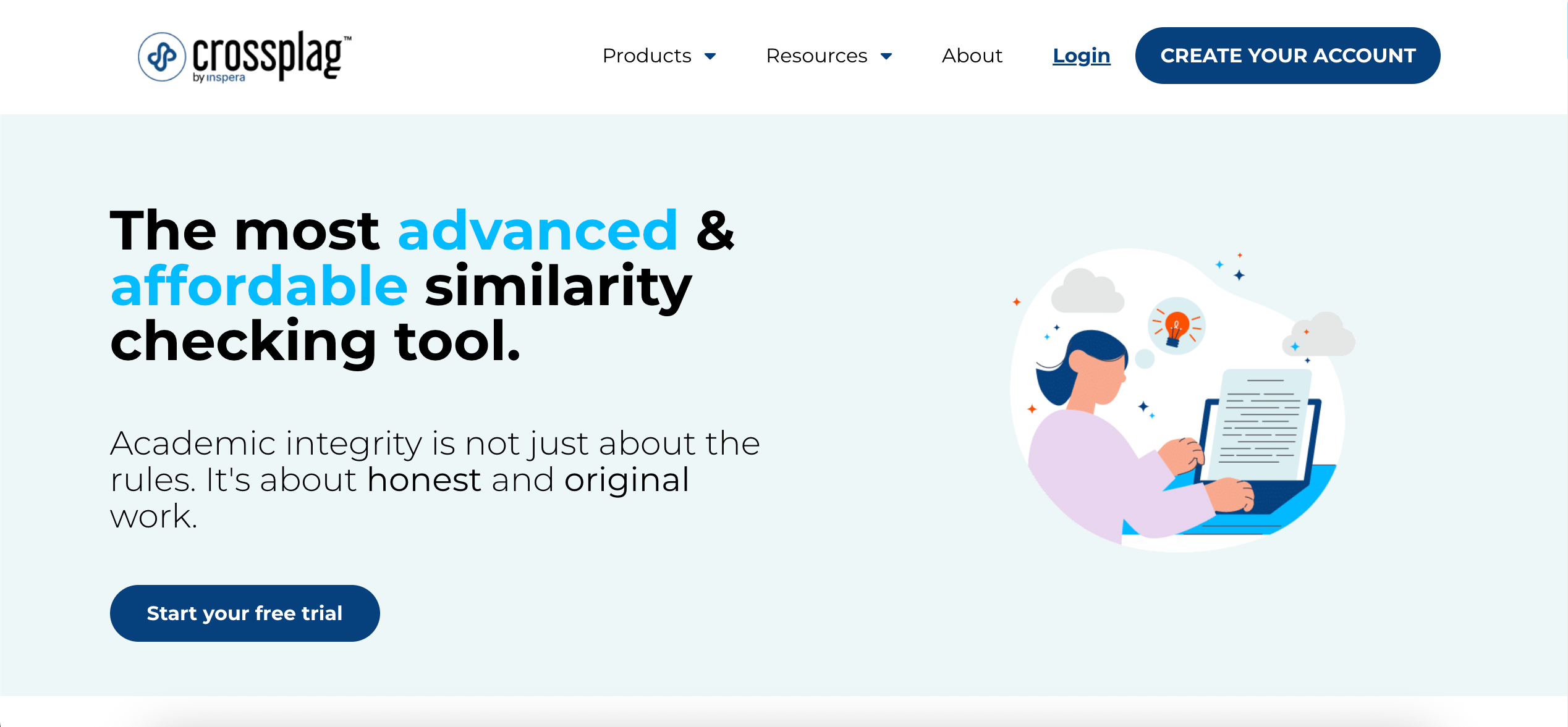AI Tools
Is Crossplag AI Detector Legit? 2025 Unbiased Review & Guide
- Jul 31, 2025

Here in 2025, AI-generated content has become incredibly sophisticated. This leaves educators, content creators, and businesses with the difficult job of separating human writing from machine output. Crossplag AI Detector promises a dual-purpose solution, combining AI detection with traditional plagiarism checking. As someone who tests these tools for a living, I've seen how a gap between marketing claims and actual performance can cause chaos. I'm going to look at Crossplag's real-world accuracy using independent data and user experiences to help you decide if it belongs in your toolkit.
Company Background and History
Crossplag was founded by Besart Kunushevci in 2016 in Kosovo, initially focusing on plagiarism detection software 3. After studying Finance and Accounting at the University of Sheffield, Kunushevci aimed to fix academic integrity issues, particularly in detecting both single-language and translation plagiarism.
Key Company Milestones:
- 2018: Launched first anti-plagiarism system supporting Albanian and cross-language detection
- 2023: Launched AI Content Detector using machine learning with 1.5+ billion parameters
- 2023: Acquired by Inspera, a Norwegian digital assessment company
The company has gained significant recognition in academic circles:
- Rated top 3 globally by European Network for Academic Integrity (ENAI)
- Ranked 1st in single-source detection by ENAI in 2020
- Used at prestigious institutions including Harvard, Yale, and Georgetown Universities
- Currently serves users in 160 countries through Inspera
What Is Crossplag AI Detector?
Crossplag is a dual-purpose tool that identifies both AI-generated content and traditional plagiarism. The detector uses RoBERTa-based machine learning models with 1.5+ billion parameters trained on proprietary datasets to analyze text patterns characteristic of machine-generated writing.
Core Features:
- Language Support: 100+ languages (English provides highest accuracy)
- File Formats: .doc, .docx, .pdf, .txt
- Batch Processing: Multiple document uploads simultaneously
- API Integration: Embedding within learning management systems
- Cross-language Detection: Industry-first capability to detect translation plagiarism
The AI detection component cross-references submissions against 100+ billion web pages and academic databases while applying machine learning classifiers to identify AI patterns.
Traditional Plagiarism Detection Performance
Before examining AI detection capabilities, Crossplag's traditional plagiarism detection shows strong performance metrics:
- Detection Accuracy: 98.5% detection rate
- False Positive Rate: 0.5% for plagiarism detection
- Database Size: 100+ billion texts from web pages, academic journals, books, articles, and websites
This solid performance in plagiarism detection serves as the base for their newer AI detection features.
Crossplag AI Detector Comparison Overview
How to Use Crossplag: Step-by-Step Process
Step 1: Sign Up and Access
- Create an account or log in to the Crossplag platform
- Choose between a free trial (1,000 words) or a paid plan
Step 2: Document Upload
- Upload a document (.doc, .docx, .pdf, .txt) or paste text directly
- The system supports batch processing for multiple documents
Step 3: Initiate Analysis
- Click "Check" to begin the analysis
- The system processes and compares against its database
Step 4: Review Results
Generated reports include color-coded highlighting:
- Red: Detected plagiarism from other sources
- Blue: Reordered or paraphrased but flagged content
- Green: Properly cited quotations
Step 5: Download Reports
- Detailed reporting: Similarity percentage, source links, author info, word count
- Download options: PDF reports, e-certificates, MLPlag reports
Processing typically completes quickly.
AI Detection Accuracy Analysis
Performance with Different AI Models
Crossplag shows mixed results with AI models. Testing data reveals the detector achieves 78-85% accuracy when analyzing content from older AI models like GPT-3.5, typically generating confidence scores exceeding 70%. Meanwhile, initiatives like the NIST AI Text Detection and Authentication Challenge aim to benchmark and improve detection tools. However, this accuracy drops dramatically, by 17-22 percentage points, when confronted with content from advanced models like GPT-4 and Claude. Processing speeds remain consistently efficient at 2-3 seconds per analysis regardless of text length.
False Positive Problems
For me, the most significant issue is the high false positive rate when analyzing human-written text. It reminds me of testing a similar tool with a passage from a 19th-century novel, only to have it flagged as 99% AI. When a tool can't tell the difference between Charles Dickens and ChatGPT, you have a problem.
Independent testing reveals alarming misidentification patterns:
| Content Type | False Positive Rate |
|---|---|
| Academic papers | 30% |
| Technical documentation | 25% |
| Business writing | 23% |
This means nearly one in four legitimate human-written texts may be incorrectly labeled as AI-generated, which creates serious problems for academic integrity processes and content verification workflows.
Consistency Issues
Crossplag also has a consistency problem. Identical texts submitted consecutively generated conflicting results in 37% of trial runs, with technical writing samples showing the widest variance, identical methodology sections alternated between 15% and 92% AI-confidence scores in repeated testing.
Blended Content Detection
The tool also has a hard time with hybrid human-AI content. The detector regularly produces inconclusive mid-range confidence scores (40-60%) for 68% of blended samples. This uncertainty becomes even more pronounced with AI-edited human content, resulting in diagnostic confusion 89% of the time.
Crossplag vs Competitor Comparison
When compared against leading alternatives, Crossplag's performance gaps become apparent:
| Detector | False Positive Rate | GPT-4 Detection | Humanized Content Detection |
|---|---|---|---|
| Humanizer AI | <1% | 95% | 52% |
| Crossplag | 27% | 58% | 18% |
| Turnitin | <2% | 73% | 35% |
| GPTZero | 5% | 81% | 40% |
| Originality.ai | 3% | 87% | 32% |
| Undetectable AI | 4% | 92% | 45% |
| Copyleaks AI Detector | - | - | - |
| Winston AI detector | - | - | - |
Key Findings:
- Turnitin maintains less than 2% false positive rates compared to Crossplag's 27%
- Undetectable AI correctly identified 100% of AI-generated samples that Crossplag misclassified
- GPTZero demonstrated 22% higher detection accuracy for humanized content
Pricing and Plans Structure
Individual Plans
- Free Trial: Up to 1,000 words or 10 credits
- Basic Plan: $9.99 for 50 credits (5,000 words)
- Bundle Plans: $149.99 for 1,000 credits (100,000 words)
Institutional Pricing
- Education: Starting at $1 per user per year
- Business/Enterprise: Custom pricing with admin panels and API access
Free vs. Paid Feature Comparison
| Feature | Free Version | Paid Plans |
|---|---|---|
| Word Limit | Up to 1,000 words | Higher limits based on plan |
| Reporting | Basic reporting | Detailed analytics |
| Support | Standard email | Priority support |
| Advanced Features | Limited | Full access |
There is no evidence of different data retention policies or privacy protections between free and paid tiers. The AI models are trained on proprietary datasets, not user submissions.
Technical Integration and API Support
Platform Compatibility
Crossplag supports integration with major learning management systems:
- Moodle
- Canvas
- Blackboard
Infrastructure Details
- Primary servers: AWS (Milano and Frankfurt)
- Additional support: Azure and Google Cloud Platform
- LTI standards support for LMS integration
- Multi-platform support: Web, Android, and iOS applications
Customer Support Channels
- Email support
- Help desk and FAQs
- Knowledge base
- Phone support
- Live chat
Data Privacy and Content Retention
Crossplag has straightforward privacy policies with key protections:
- Temporary Storage: Documents are stored temporarily unless users opt-in for longer retention
- No Training Use: No evidence suggests user content is used for AI model training
- Proprietary Training: AI models are trained on proprietary datasets, not user submissions
- Deletion Options: Document deletion capabilities are available
- Compliance: The service has server-side encryption and non-retention policies compliant with FERPA and GDPR regulations.
Real User Experiences

User feedback shows consistent patterns. These numbers aren't abstract; they represent real frustrations for people using the tool.
Academic Users
Educators report high false positive rates with student papers, particularly in technical disciplines. One professor noted: "We had to abandon Crossplag after 12 of 40 students were falsely flagged for AI use in their chemistry lab reports."
Content Creators
Digital publishers struggle with inconsistent results. A content marketing director shared: "Same blog post scanned three times gave us scores of 32%, 61%, and 44%. We can't build verification workflows on such variable results."
Business Applications
Corporate users find limited value compared to specialized alternatives. Some appreciate its use for initial screening, with one noting: "It's useful for a first-pass check of obvious AI content, but we always verify positive hits with other tools."
When Crossplag Works Well
Despite its limitations, Crossplag has some legitimate use cases:
- Preliminary screening: Identifying obvious AI-generated content for further review
- Educational settings: Environments needing combined plagiarism and AI checks under tight budgets
- Low-stakes verification: Content assessments where false positives won't have serious consequences
- Workflow efficiency: Organizations requiring dual detection without investing in multiple tools
When to Avoid Crossplag
Crossplag is unsuitable for:
- High-stakes academic or disciplinary decisions
- Technical or academic publishing verification
- Advanced AI model detection (GPT-4, Claude 3)
- Situations with serious consequences for false positives
- Legal or compliance purposes requiring consistent results
Given the 27% false positive rate, no important decision should rely on Crossplag alone.
Better Alternatives to Consider
For more reliable detection, consider these specialized alternatives:
- Turnitin
- Originality.ai
- GPTZero
- Undetectable AI
- Copyleaks AI Detector
- Winston AI detector
- Sapling AI detector
- Content at Scale AI detector
Final Verdict: Is Crossplag AI Detector Legit?
From a business and technical perspective, Crossplag is a legitimate tool with proper data protection protocols and established academic recognition. The company has a solid track record in plagiarism detection, earning top rankings from ENAI and adoption by prestigious universities.
However, as someone deep in this field, I can tell you that “legitimate” does not mean “reliable,” especially for AI detection. Key concerns include:
- High false positive rates (27% vs. <2% for Turnitin)
- Poor performance with newer AI models (GPT-4, Claude 3)
- Significant consistency issues (37% variance in repeat testing)
- Limited transparency regarding algorithmic improvements
Bottom Line
Use Crossplag only as one part of a multi-step detection process. It should never be the only tool you use for important decisions. While its established plagiarism detection capabilities provide value, the AI detection component needs major improvements to compete with the top tools.
For educators and content managers who need reliable AI detection, it makes more sense to invest in specialized tools like Turnitin or Originality.ai instead of relying on Crossplag's current AI detection features.
